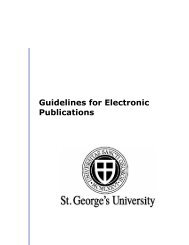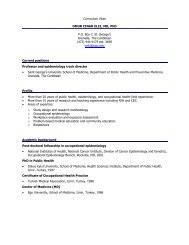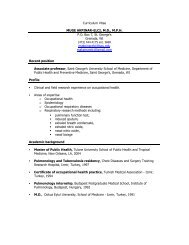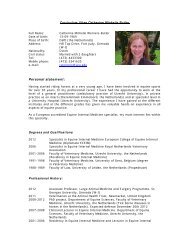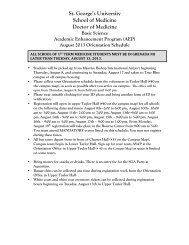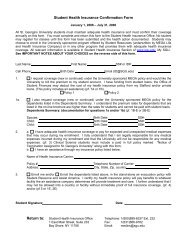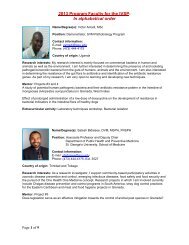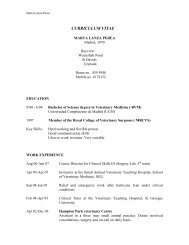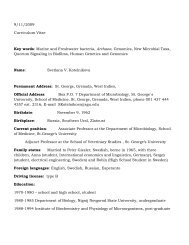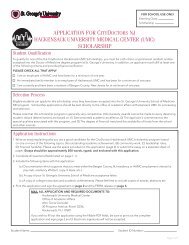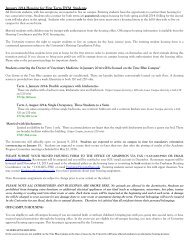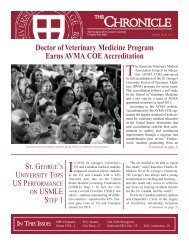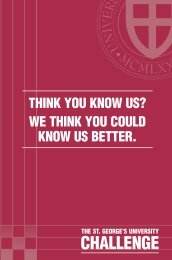SCHOOL OF 2012-2013 - St. George's University
SCHOOL OF 2012-2013 - St. George's University
SCHOOL OF 2012-2013 - St. George's University
Create successful ePaper yourself
Turn your PDF publications into a flip-book with our unique Google optimized e-Paper software.
and surgical conditions. <strong>St</strong>udents learn to formulate<br />
appropriately organized and succinct medical records<br />
and problem lists. <strong>St</strong>udents are familiarized with the<br />
indications, limitations, and methodology of emergency<br />
department (ED) diagnostic procedures and introduced<br />
to the multifaceted psychological, social, and economic<br />
challenges faced in an emergency medical setting.<br />
<strong>St</strong>udents function under the direct supervision of the ED<br />
faculty. During the rotation, students attend departmental<br />
conferences, lectures, skills labs, and teaching rounds.<br />
Evaluations are based on clinical performance, written<br />
examination, and case-log presentations.<br />
Family Medicine and General Practice<br />
Everett Schlam, MD, Chair<br />
The goals of the family medicine and general practice<br />
rotation are to ensure that all medical students have a full<br />
understanding and appreciation of an integrative approach<br />
to the care of patients, families, and communities. <strong>St</strong>udents<br />
will be introduced to the aspects of family medicine that<br />
are applicable to all fields of medical practice, including<br />
comprehensive and continuous care provided by family<br />
physicians to patients of all ages. The importance of family<br />
systems and the impact of chronic illness on patients<br />
and their families will be incorporated into patient care.<br />
<strong>St</strong>udents will accompany precept physicians performing<br />
patient care in the office setting, nursing home, and<br />
house calls. Participation in community services involving<br />
health care will be encouraged. By the end of the rotation,<br />
students will be expected to perform and present a<br />
focused patient history and physical examination to<br />
diagnose and manage patients. <strong>St</strong>udents will be able to<br />
provide effective patient education and utilize evidencebased<br />
decision making in clinical practice. <strong>St</strong>udents will use<br />
the Fifth Edition of Sloan’s Essentials of Family Medicine as<br />
a text for the rotation.<br />
Graduate <strong>St</strong>udies Program<br />
Anatomical Sciences<br />
Marios Loukas, MD, PhD, Chair<br />
ANAT 801<br />
Educational Development<br />
This course will give graduate students the opportunity to<br />
enhance their general anatomical knowledge and explore<br />
in greater detail areas of the body that were covered<br />
only superficially in previous coursework. This course will<br />
enable students to enter their fields of interest prepared to<br />
effectively teach pertinent concepts and applied anatomy<br />
in that field, as well as allow students to prepare a body<br />
of work with educational value for future students by<br />
developing educational materials through dissection or<br />
other media forms, such as computer or medical imaging.<br />
<strong>St</strong>udents will learn various techniques involved in the<br />
preparation of cadaveric material for display and teaching,<br />
including dry bone/ligamentous preps, plastic embedding,<br />
and various plastination procedures.<br />
ANAT 802<br />
Special Regional Dissection<br />
This course allows students to hone their dissection<br />
expertise, as well as their academic and three-dimensional<br />
understanding of a particular body area through detailed<br />
cadaveric dissection.<br />
<strong>St</strong>udents will produce prosecutions for the department while<br />
gaining a chance to learn a particular region of the body in<br />
great and professional-level detail, well beyond that covered<br />
in the standard anatomy course. Project topics focus around<br />
four regions, which are head and neck; back and thorax;<br />
extremities; and abdomen, pelvis, and perineum. Each<br />
regional dissection will be limited to the appropriate area<br />
and will be a complete dissection of all the structures within<br />
the topic area, either through one or a series of dissections.<br />
Each project will be researched, dissected, and presented to<br />
the faculty and peers of students involved.<br />
ANAT 803/ANAT 813<br />
Instructional Development I/ Instructional Development II<br />
Instructional Development is an elective or selective to<br />
assist students with the development of their teaching skills<br />
and topic proficiency by providing teaching opportunities<br />
in the core anatomical science courses (Human Gross and<br />
Developmental Anatomy, Embryology, Histology and Cell<br />
Biology, or Neuroanatomy). This course is designed to<br />
provide students with practical teaching experience as a<br />
teaching assistant. They must either pass the course that<br />
they wish to teach with a minimum passing grade of a “B,”<br />
or they must have permission of the course director to<br />
waive such a prerequisite. As graduate teaching assistants,<br />
they will be required to attend and teach in the relevant<br />
labs, in addition to the preparation and delivery of two<br />
lectures throughout the term to faculty and, upon approval<br />
of faculty, to students of the course.<br />
School of Medicine<br />
Course Descriptions<br />
School of Medicine Catalog <strong>2013</strong>–2014 | 77



